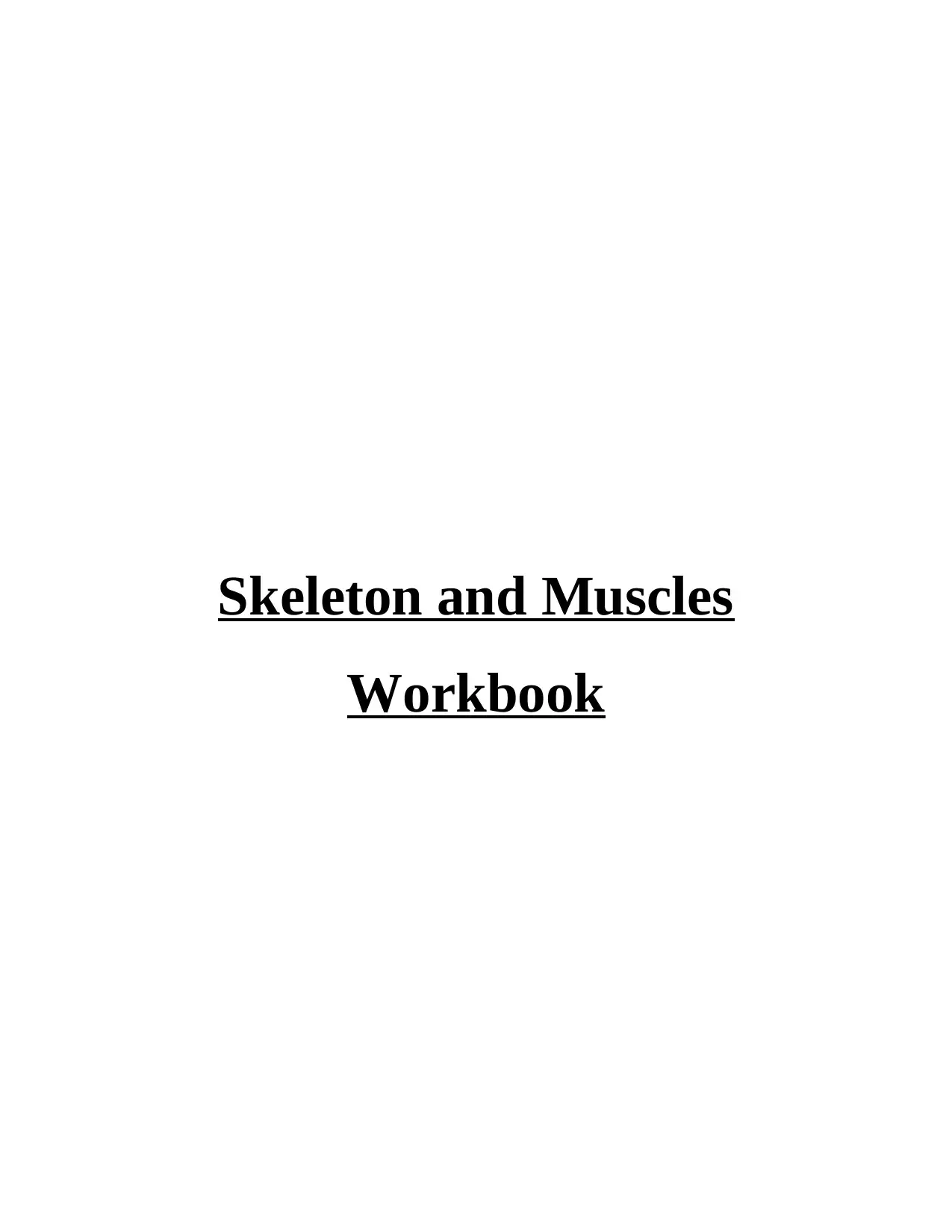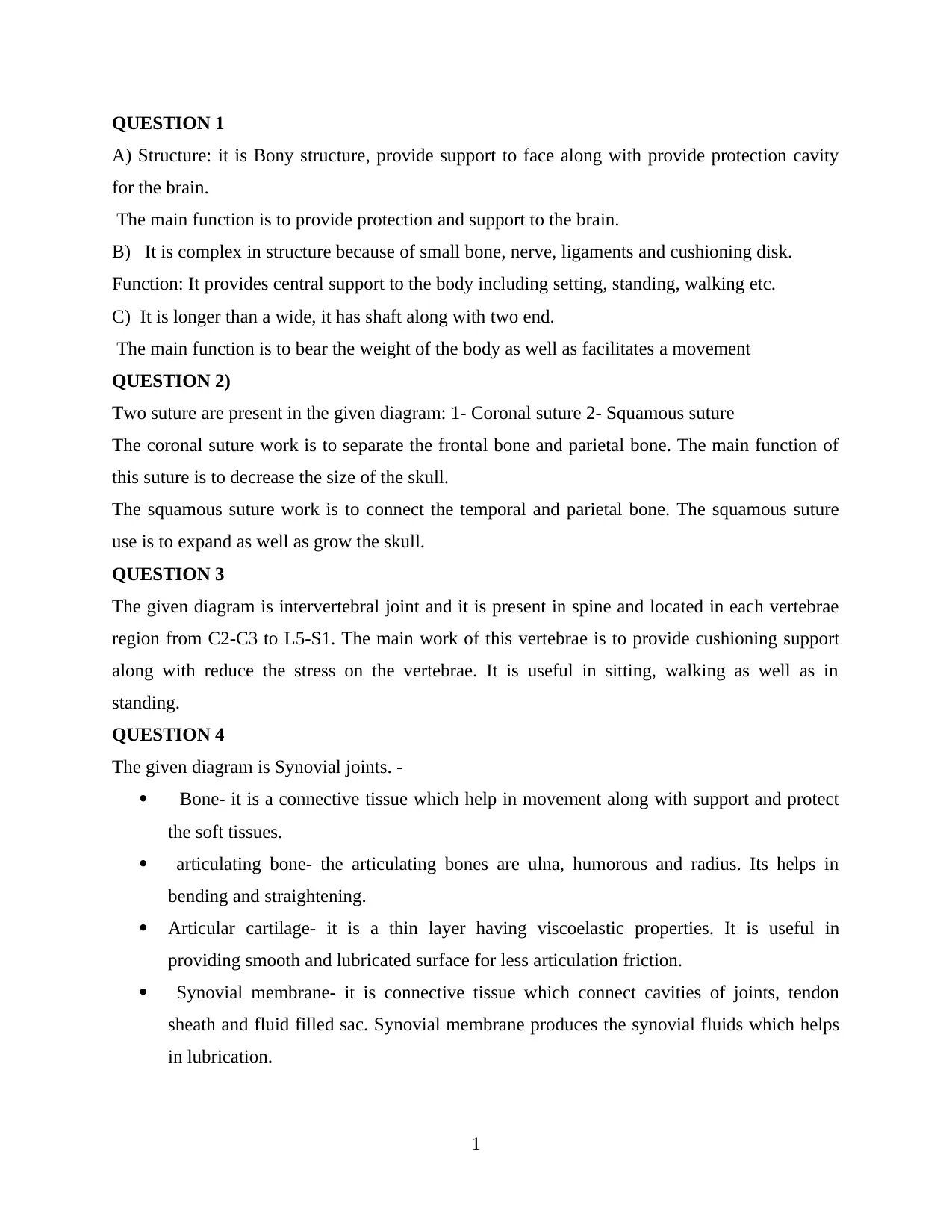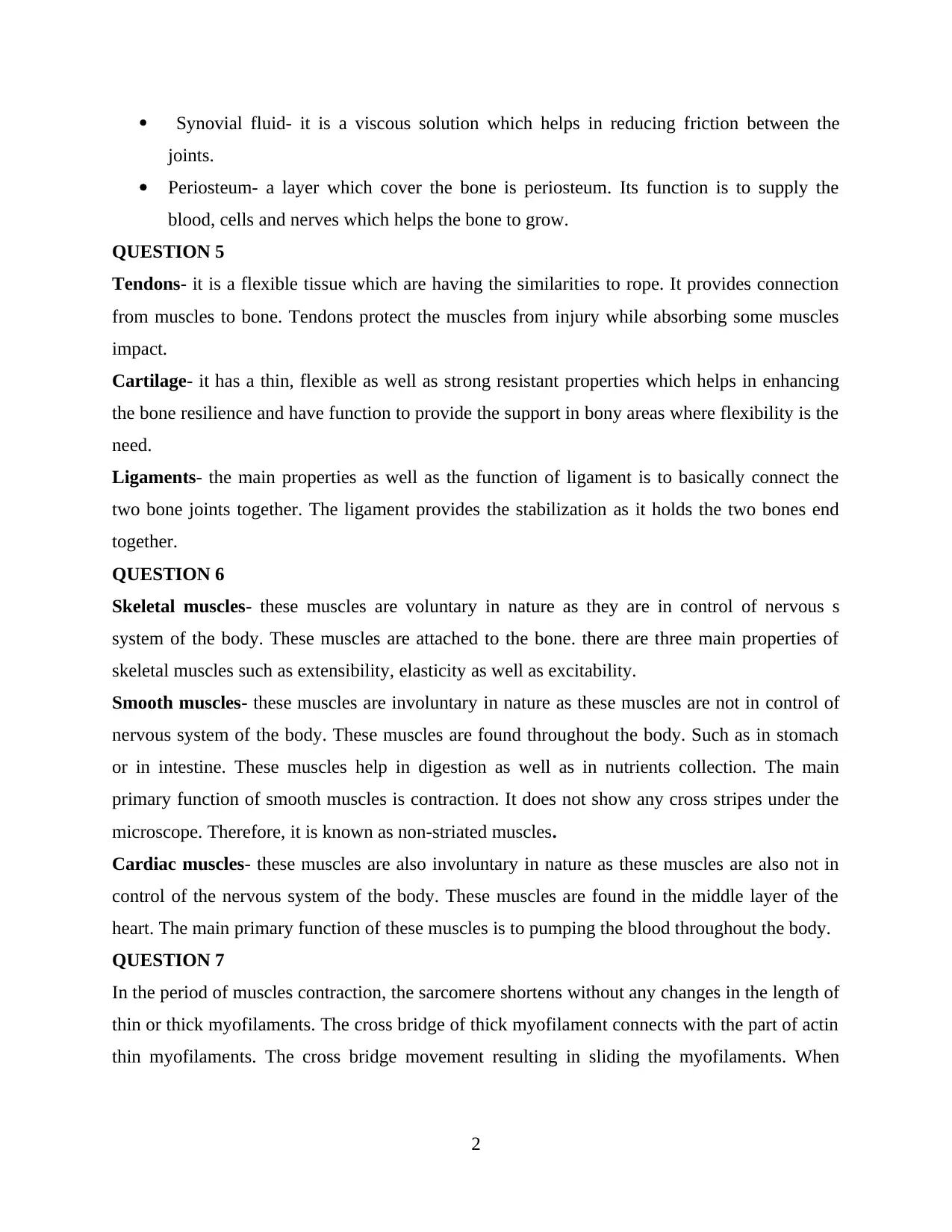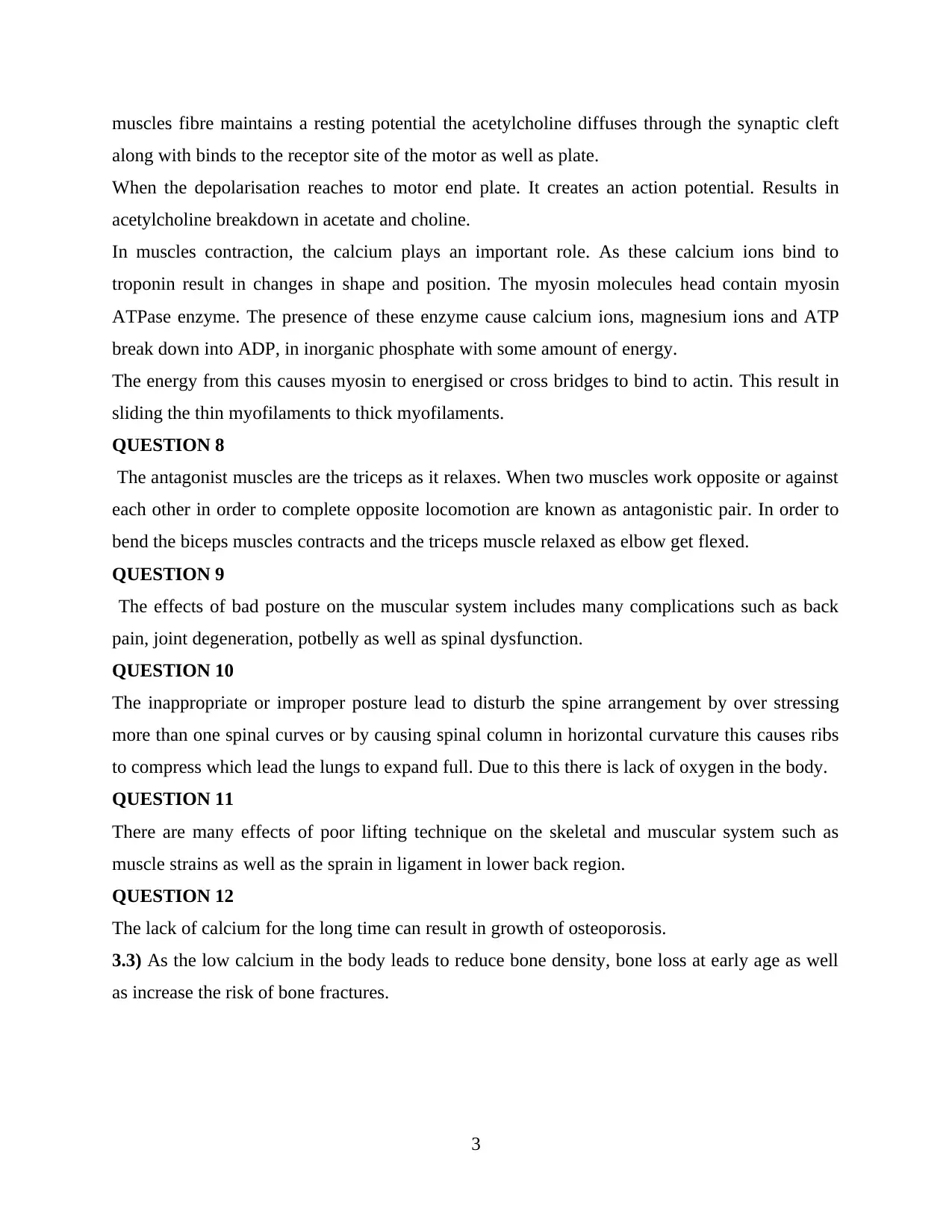Comprehensive Analysis of the Skeletal and Muscular Systems
VerifiedAdded on 2023/06/08
|7
|1094
|137
Homework Assignment
AI Summary
This assignment provides a detailed overview of the skeletal and muscular systems, covering topics such as bone structure, joint function, muscle types, and the mechanics of muscle contraction. It identifies sutures in the skull, explains the function of intervertebral joints, and describes the components of synovial joints. The homework further differentiates between tendons, cartilage, and ligaments, and compares skeletal, smooth, and cardiac muscles. It also elaborates on the process of muscle contraction, the role of antagonist muscles, and the effects of bad posture and improper lifting techniques on the musculoskeletal system. The assignment concludes by discussing the impact of calcium deficiency on bone health and the risk of osteoporosis. Desklib provides a platform for students to access such solved assignments and study resources.

Skeleton and Muscles
Workbook
Workbook
Paraphrase This Document
Need a fresh take? Get an instant paraphrase of this document with our AI Paraphraser


QUESTION 1
A) Structure: it is Bony structure, provide support to face along with provide protection cavity
for the brain.
The main function is to provide protection and support to the brain.
B) It is complex in structure because of small bone, nerve, ligaments and cushioning disk.
Function: It provides central support to the body including setting, standing, walking etc.
C) It is longer than a wide, it has shaft along with two end.
The main function is to bear the weight of the body as well as facilitates a movement
QUESTION 2)
Two suture are present in the given diagram: 1- Coronal suture 2- Squamous suture
The coronal suture work is to separate the frontal bone and parietal bone. The main function of
this suture is to decrease the size of the skull.
The squamous suture work is to connect the temporal and parietal bone. The squamous suture
use is to expand as well as grow the skull.
QUESTION 3
The given diagram is intervertebral joint and it is present in spine and located in each vertebrae
region from C2-C3 to L5-S1. The main work of this vertebrae is to provide cushioning support
along with reduce the stress on the vertebrae. It is useful in sitting, walking as well as in
standing.
QUESTION 4
The given diagram is Synovial joints. -
Bone- it is a connective tissue which help in movement along with support and protect
the soft tissues.
articulating bone- the articulating bones are ulna, humorous and radius. Its helps in
bending and straightening.
Articular cartilage- it is a thin layer having viscoelastic properties. It is useful in
providing smooth and lubricated surface for less articulation friction.
Synovial membrane- it is connective tissue which connect cavities of joints, tendon
sheath and fluid filled sac. Synovial membrane produces the synovial fluids which helps
in lubrication.
1
A) Structure: it is Bony structure, provide support to face along with provide protection cavity
for the brain.
The main function is to provide protection and support to the brain.
B) It is complex in structure because of small bone, nerve, ligaments and cushioning disk.
Function: It provides central support to the body including setting, standing, walking etc.
C) It is longer than a wide, it has shaft along with two end.
The main function is to bear the weight of the body as well as facilitates a movement
QUESTION 2)
Two suture are present in the given diagram: 1- Coronal suture 2- Squamous suture
The coronal suture work is to separate the frontal bone and parietal bone. The main function of
this suture is to decrease the size of the skull.
The squamous suture work is to connect the temporal and parietal bone. The squamous suture
use is to expand as well as grow the skull.
QUESTION 3
The given diagram is intervertebral joint and it is present in spine and located in each vertebrae
region from C2-C3 to L5-S1. The main work of this vertebrae is to provide cushioning support
along with reduce the stress on the vertebrae. It is useful in sitting, walking as well as in
standing.
QUESTION 4
The given diagram is Synovial joints. -
Bone- it is a connective tissue which help in movement along with support and protect
the soft tissues.
articulating bone- the articulating bones are ulna, humorous and radius. Its helps in
bending and straightening.
Articular cartilage- it is a thin layer having viscoelastic properties. It is useful in
providing smooth and lubricated surface for less articulation friction.
Synovial membrane- it is connective tissue which connect cavities of joints, tendon
sheath and fluid filled sac. Synovial membrane produces the synovial fluids which helps
in lubrication.
1
⊘ This is a preview!⊘
Do you want full access?
Subscribe today to unlock all pages.

Trusted by 1+ million students worldwide

Synovial fluid- it is a viscous solution which helps in reducing friction between the
joints.
Periosteum- a layer which cover the bone is periosteum. Its function is to supply the
blood, cells and nerves which helps the bone to grow.
QUESTION 5
Tendons- it is a flexible tissue which are having the similarities to rope. It provides connection
from muscles to bone. Tendons protect the muscles from injury while absorbing some muscles
impact.
Cartilage- it has a thin, flexible as well as strong resistant properties which helps in enhancing
the bone resilience and have function to provide the support in bony areas where flexibility is the
need.
Ligaments- the main properties as well as the function of ligament is to basically connect the
two bone joints together. The ligament provides the stabilization as it holds the two bones end
together.
QUESTION 6
Skeletal muscles- these muscles are voluntary in nature as they are in control of nervous s
system of the body. These muscles are attached to the bone. there are three main properties of
skeletal muscles such as extensibility, elasticity as well as excitability.
Smooth muscles- these muscles are involuntary in nature as these muscles are not in control of
nervous system of the body. These muscles are found throughout the body. Such as in stomach
or in intestine. These muscles help in digestion as well as in nutrients collection. The main
primary function of smooth muscles is contraction. It does not show any cross stripes under the
microscope. Therefore, it is known as non-striated muscles.
Cardiac muscles- these muscles are also involuntary in nature as these muscles are also not in
control of the nervous system of the body. These muscles are found in the middle layer of the
heart. The main primary function of these muscles is to pumping the blood throughout the body.
QUESTION 7
In the period of muscles contraction, the sarcomere shortens without any changes in the length of
thin or thick myofilaments. The cross bridge of thick myofilament connects with the part of actin
thin myofilaments. The cross bridge movement resulting in sliding the myofilaments. When
2
joints.
Periosteum- a layer which cover the bone is periosteum. Its function is to supply the
blood, cells and nerves which helps the bone to grow.
QUESTION 5
Tendons- it is a flexible tissue which are having the similarities to rope. It provides connection
from muscles to bone. Tendons protect the muscles from injury while absorbing some muscles
impact.
Cartilage- it has a thin, flexible as well as strong resistant properties which helps in enhancing
the bone resilience and have function to provide the support in bony areas where flexibility is the
need.
Ligaments- the main properties as well as the function of ligament is to basically connect the
two bone joints together. The ligament provides the stabilization as it holds the two bones end
together.
QUESTION 6
Skeletal muscles- these muscles are voluntary in nature as they are in control of nervous s
system of the body. These muscles are attached to the bone. there are three main properties of
skeletal muscles such as extensibility, elasticity as well as excitability.
Smooth muscles- these muscles are involuntary in nature as these muscles are not in control of
nervous system of the body. These muscles are found throughout the body. Such as in stomach
or in intestine. These muscles help in digestion as well as in nutrients collection. The main
primary function of smooth muscles is contraction. It does not show any cross stripes under the
microscope. Therefore, it is known as non-striated muscles.
Cardiac muscles- these muscles are also involuntary in nature as these muscles are also not in
control of the nervous system of the body. These muscles are found in the middle layer of the
heart. The main primary function of these muscles is to pumping the blood throughout the body.
QUESTION 7
In the period of muscles contraction, the sarcomere shortens without any changes in the length of
thin or thick myofilaments. The cross bridge of thick myofilament connects with the part of actin
thin myofilaments. The cross bridge movement resulting in sliding the myofilaments. When
2
Paraphrase This Document
Need a fresh take? Get an instant paraphrase of this document with our AI Paraphraser

muscles fibre maintains a resting potential the acetylcholine diffuses through the synaptic cleft
along with binds to the receptor site of the motor as well as plate.
When the depolarisation reaches to motor end plate. It creates an action potential. Results in
acetylcholine breakdown in acetate and choline.
In muscles contraction, the calcium plays an important role. As these calcium ions bind to
troponin result in changes in shape and position. The myosin molecules head contain myosin
ATPase enzyme. The presence of these enzyme cause calcium ions, magnesium ions and ATP
break down into ADP, in inorganic phosphate with some amount of energy.
The energy from this causes myosin to energised or cross bridges to bind to actin. This result in
sliding the thin myofilaments to thick myofilaments.
QUESTION 8
The antagonist muscles are the triceps as it relaxes. When two muscles work opposite or against
each other in order to complete opposite locomotion are known as antagonistic pair. In order to
bend the biceps muscles contracts and the triceps muscle relaxed as elbow get flexed.
QUESTION 9
The effects of bad posture on the muscular system includes many complications such as back
pain, joint degeneration, potbelly as well as spinal dysfunction.
QUESTION 10
The inappropriate or improper posture lead to disturb the spine arrangement by over stressing
more than one spinal curves or by causing spinal column in horizontal curvature this causes ribs
to compress which lead the lungs to expand full. Due to this there is lack of oxygen in the body.
QUESTION 11
There are many effects of poor lifting technique on the skeletal and muscular system such as
muscle strains as well as the sprain in ligament in lower back region.
QUESTION 12
The lack of calcium for the long time can result in growth of osteoporosis.
3.3) As the low calcium in the body leads to reduce bone density, bone loss at early age as well
as increase the risk of bone fractures.
3
along with binds to the receptor site of the motor as well as plate.
When the depolarisation reaches to motor end plate. It creates an action potential. Results in
acetylcholine breakdown in acetate and choline.
In muscles contraction, the calcium plays an important role. As these calcium ions bind to
troponin result in changes in shape and position. The myosin molecules head contain myosin
ATPase enzyme. The presence of these enzyme cause calcium ions, magnesium ions and ATP
break down into ADP, in inorganic phosphate with some amount of energy.
The energy from this causes myosin to energised or cross bridges to bind to actin. This result in
sliding the thin myofilaments to thick myofilaments.
QUESTION 8
The antagonist muscles are the triceps as it relaxes. When two muscles work opposite or against
each other in order to complete opposite locomotion are known as antagonistic pair. In order to
bend the biceps muscles contracts and the triceps muscle relaxed as elbow get flexed.
QUESTION 9
The effects of bad posture on the muscular system includes many complications such as back
pain, joint degeneration, potbelly as well as spinal dysfunction.
QUESTION 10
The inappropriate or improper posture lead to disturb the spine arrangement by over stressing
more than one spinal curves or by causing spinal column in horizontal curvature this causes ribs
to compress which lead the lungs to expand full. Due to this there is lack of oxygen in the body.
QUESTION 11
There are many effects of poor lifting technique on the skeletal and muscular system such as
muscle strains as well as the sprain in ligament in lower back region.
QUESTION 12
The lack of calcium for the long time can result in growth of osteoporosis.
3.3) As the low calcium in the body leads to reduce bone density, bone loss at early age as well
as increase the risk of bone fractures.
3

4
⊘ This is a preview!⊘
Do you want full access?
Subscribe today to unlock all pages.

Trusted by 1+ million students worldwide

:
5
5
1 out of 7
Related Documents
Your All-in-One AI-Powered Toolkit for Academic Success.
+13062052269
info@desklib.com
Available 24*7 on WhatsApp / Email
![[object Object]](/_next/static/media/star-bottom.7253800d.svg)
Unlock your academic potential
Copyright © 2020–2025 A2Z Services. All Rights Reserved. Developed and managed by ZUCOL.





